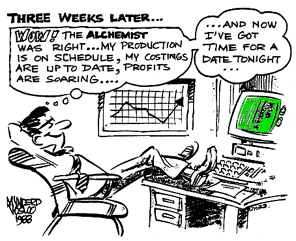 |
 |
 |
COSTINGS, PRICES, STOCK
VALUE AND ACCOUNTING CALCULATING COSTS OF MANUFACTURED PRODUCTS In
ALCHEMIST cost calculations may take place
in the following instances, depending on settings: 1] Running an ALCHEMIST
costing report <Stock><Reports><Alchemist><Products>[Costing]. 2] Invoking a manual re-cost of a stock
item in
<Stock><Maintenance><Products>[Alchemist]<Calculate Product Cost> 3] On This function depends upon a setting in <Stock><Maintenance><Global
Settings / Functions><Alchemist Setup><Goods Finished>
“Re-cost Product” (Yes or No) – If set to “Yes” every manufactured
item will be re-costed at the time of manufacture (Processing the
Goods Finished) NOTE:
BOM items
and Kits are not costed when running the The
Costing
is done by default using the last cost of the materials used in
manufacturing the You
may, however elect to use a different material cost as the basis
for costing. This is achieved by allocating a special Category to the material item that
you want to use differently in the calculation. (See
<Stock><Maintenance><Stock Items><Categories>). This
category should be set to use a different cost as the basis for
performing the costing of the manufactured For an explanation of categories see
page 5. For reasons outlined
below, one should be very careful when using other costs as the
basis for calculating costs of manufactured items. Formulations
costs may be calculated separately from the COSTS AVAILABLE FOR CALCULATIONS OF
SELLING PRICES AND VALUATION OF STOCK In
ALCHEMIST and EXACT there are five different
costs available for selection: These
are seen in <Stock><Maintenance><Stock
Items><Items>(or Products, Raw Materials or Containers)[Purchases
/ Qty / Cost] Note
that all costs refer to the Stored / Sold in unit The
system manager or a user with a similar level of access may access
the costs for editing by 1]
Last Cost - the last cost of an item when
it was received or manufactured 2]
Average Cost - the averaged cost of an
item 3]
Standard Cost – a “benchmark” figure that
can be used to see when other costs have moved significantly 4]
Valuation Cost – a user-edited cost that
may be used for valuation purposes where, for example there is a
de 5]
Edited Cost – a user-edited cost that
may be used, for example in the case of an imported raw material
where the normal purchase A
mark-up factor may be associated with an Edited Cost and used to
automatically arrive at the Edited Cost by multiplying the Last
Cost by the factor. This is to assist in automatic maintenance of
Edited Costs. Please
note that only the first two costs, above are fully automatically
maintained by the system. The other costs must be carefully maintained
by the user, although different costs may be transferred to other
costs globally by invoking <Stock><Maintenance><Stock Items><Transfer
Values> It
can be seen from the above that costing can be done on any costs
of materials, but one must be very clear on what cost one is looking
at and for what purpose those costs are to be used. For
example: Visualise
the following scenario: A
customer purchases This
may work if the customer buys the To
value your stock at average value may not be such a bad idea, but
to base your It
is better to arrive at an average cost of the finished item based
on the latest cost of the raw materials at the time of manufacture.
You can then base your selling price on this average cost. The
idea when determining In fact, although possible with Alchemist,
average costs of raw materials should never be used as the basis
for calculating the latest costs of finished STOCK VALUATION Stock
may be valued at any of the above costs. The
stock valuation report is found at <Stock><Reports><Standard
Items><Stock Value> Various
choices that are self-explanatory may be selected from the reports
menu. Stock
valuation is the Quantity on Hand multiplied by the selected cost
of the This
means that the user may selectively decide on those Negative Values in Stock Valuation Stock
may reflect negative values in the following cases: 1]
Materials have been received but the goods received vouchers have
not been 2]
Goods have been manufactured and then sold, but the batches have
not been 3]
Decanting has occurred without using the decanting facility. See
<Stock><Maintenance><Stock Items>Operations<Move
/ Decant> 4]
There is stock leakage in the form of theft or un- 5]
Batch sheets have been incorrectly Stock
may reflect incorrect positive values in any of the above scenarios
or: 1]
Goods have been returned to stock without the documentation having
been It therefore follows
that all negative values and all variances in a stock valuation
need to be investigated and fully explained. This is something the
computer cannot control, and it is up to management to ensure that
this is done. PRICING Alchemist
handles Items
that are sold may have an infinite number of Individual
customers may have their own Price
lists may be based on any of the selectable costings (Last, Average,
Standard, Edited or Valuation) Price
lists may have a mark-up factor associated with them that may be
used to automatically calculate new Prices
are maintained in the following areas of ALCHEMIST and EXACT: <Stock><Maintenance><Global
Settings / Functions><Default Prices> (for creating new price lists and allocating these
lists to stock items) <Stock><Maintenance><Global
Settings / Functions><Markups> (Where markup
factors may be allocated to the different price lists that may have
different stock items associated with them) <Stock><Maintenance><Global
Settings / Functions ><Default Prices>[General] (where new price lists may be created
and those that have already been created may be modified) <Stock><Maintenance><Global
Settings / Functions ><Default Prices>[Global
Functions]
(Where price lists may be allocated to stock items) <Customers><Maintenance><Prices> (where individual customers may be
allocated special prices for selected stock items) <Stock><Maintenance><Stock
Items>Operations<Price Changes> (Where future price lists are generated and existing future
prices are turned into current prices after their implementation
date) <Customers><Maintenance><Customer>
[Balances]
(Where a default and alternative price list may be allocated (over-ridden
by a customer-specific price) a selection between VAT exclusive
prices and inclusive prices may be made and special invoice, credit
note and delivery note templates to allow for customer-specific
requirements may be allocated). Costs
that are used as the basis for the calculation of new prices as
well as existing prices may be transferred to another cost or price
(Selectable by product or product range) by going to <Stock><Maintenance><Stock
Items>Operations<Transfer Values>. STOCK IN ACCOUNTING For
the purpose of analysing business performance the value of stock
is of vital importance and therefore the following factors need
to be considered: All
discrepancies need to be investigated and corrected, as seen above. Stock
value must be considered in conjunction with creditors’ transactions.
For example, it may be acceptable to reflect a negative value for
a stock item if there is a concomitant understatement of the amount
of money due to the supplier. The
report showing the value of all Goods Received where the stock has
been updated but the suppliers invoices have not been Some
accounting packages, notably Pastel, automatically transfer the
values of any stock transactions directly to the general ledger.
We
are of the opinion that this is an extremely dangerous and undesirable
Because
of the integration of stock with the General Ledger, every time
there a discrepancy in the stock a journal has to be passed in the
ledger to correct this. Journal entries are what auditors make their
living out of, and the fewer that appear in your ledger, the less
they will be able to charge for. If
there is a stock imbalance, it should be corrected in the stock,
not in your ledger! The
only analysis of stock that the auditors can do is to do a spot
check on quantities on hand. This they will do in any event. The
same reasoning applies where you want to analyse gross Some
accountants are tempted to do this analysis through the General
Ledger by setting up special sales accounts and stock accounts for
individual customers in the Ledger. As
far as we are concerned, this analysis should take place in the
customer’s records. After all, ALCHEMIST knows what an item cost
at the time of selling it to the customer, and it knows how much
the customer paid for it, therefore ALCHEMIST can calculate the
gross margins that you make on an individual customer whatever you sell the customer without
clogging up the ledger with numerous transactions that your auditor
will gleefully charge you for examining. In
ALCHEMIST, when you wish to know your One
entry: No clogging the ledger with unnecessary transactions: No
audit fee! Gross Profits Because
ALCHEMIST and EXACT are fully integrated they “know” what a These
reports are obtained from <Customer><Reports>Stock
Item Sales<By Customer (Det)> If
there has been an error in Recommended modus operandi We
recommend that you decide how you want to cost the different items
in your stock and how you want to value your stock (you can see
from the above that ALCHEMIST and EXACT offer you an almost infinite
range of combinations and permutations) ,
then make notes on how you arrive at these results and use these
notes as your own “Operations Manual” That way you will be comparing
apples with apples each month and will not catch yourself out. CATEGORIES Categories
are used to generate and order reports in the Stock, Customers and
Suppliers modules of EXACT. They are
also used to perform certain global functions on a set of data,
for example, price updates. Categories
are extremely powerful, but because there are 8 positions available
in the category code and "wild-cards" may be used, they
can also become very complex. Considerable thought needs to go into
the setting up of an intelligent category system. It
is much better to set the categories up properly right from the
beginning than it is to try and sort out a mess later! The easiest
way to explain categories is to give some simple examples: EXAMPLE
1 If, for
example you have a shop selling paint and you sell to cash customers,
house-owners, painting contractors, industrial and commercial businesses
and farmers, you may want to categorise them accordingly so that
you could obtain reports to see where your greatest sales or profits
are generated. You may also want to send different mailings to these
people to promote special offers, or even to distribute different
price lists to them. So, you
may decide to give them the categories CUSTC (this would be specific
only to the cash acount), CUSTH (house-owners),
CUSTP (painting contractors), CUSTI AND CUSTF respectively. You may
want to further refine them in terms of, for example, whether they
have an account or pay cash, thus having CUSTHA, CUSTHC, CUSTPA,
CUSTPC, and so on. (A for Account, C for Cash) You could
then print a sales report for all sales to the cash account by asking
for a report with the category CUSTC, or you could get the same
report for all Painting Contractors by specifying the category CUSTP*
(using the * as a "wildcard") , or a report for all Painting
Contractors who have an account (CUSTPA) EXAMPLE
2 It is
recommended that most customers stick to the above format for customers, stock and suppliers because it is a simple use
of categories, however, it is possible to obtain much more depth
in reporting functions by employing the following tactics. Be warned
however! The following example, if followed to a greater extent
than the example, will get very complicated. Say you
have a hardware store that sells Tools, Paints, Electrical Appliances
and Cleaners. You may
decide that you want to give these the broad categories T, P, E
and C respectively. You may
then decide to further divide the Tools (T) category into Power
Tools (P), Garden Tools (G), Spanners (S) and Woodwork Tools (W),
so you use the second position in the category code for this and
arrive at the codes TP, TG, TS and TW. Now you
decide that you want to break down Power Tools into Drills, Sanders
and Grinders, so you get TPD, TPS and TPG. However,
in the Woodworking Tools section, you also have some hand-operated
sanding devices, so you may also have a TWS. These codes
are allocated to the stock item(s) that they describe. Now, if
you decide you want a report on all tools in your shop, all you
need to do is ask for a report with the category T* (The * being
the "wildcard" for anything in any position after the
T). If you want
a report on all Tools that are Sanders (both power and hand-held) , you could ask for T?S (The ? is a "wildcard"
for a single position). If you only
want the Power-tool Sanders, ask for the category TPS Note that in ALCHEMIST groups may be
used in a similar way to categories, but three groups (PROD, RAW
and PACK) are also essential to the correct running of ALCHEMIST.
It is therefore better to alter categories, but not to change groups. |
||